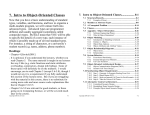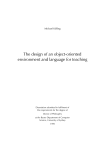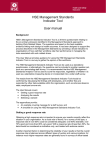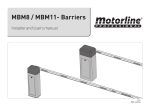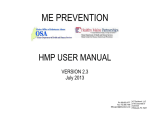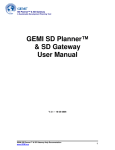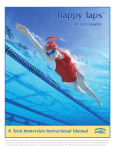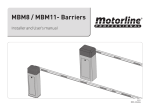Download "user manual"
Transcript
Writing Your Dissertation One Paragraph at a Time Barry Jay September 10, 2012 Preface This pamphlet provides you with the skills to write your dissertation in a methodical and timely manner. It is constructed from personal reflections on my own writing, and on that of research students who have attended my writing clinics over the years. It combines useful concepts with a series of exercises that achieve goals. The first main concept is that of the thesis. This word is often used to describe a document but in its primary meaning, a thesis is a statement, a proposition. If the statement is in doubt then it is a hypothesis. You will defend your thesis in a document, a dissertation. Your first goal will be to identify your thesis. Your second goal will be to produce a skeleton of your dissertation. If everything is perfectly clear in your mind then each of these two goals can be met in a single session. However, if your research is just beginning then it may take you a year. No matter how long they take, each and every exercise is designed to bring your submission date closer. Although we will consider all levels of structure, from word to sentence to paragraph to section to chapter, the focus will be on paragraphs. A paragraph is a collection of sentences that address a common topic. Each key idea, concept or phrase in your dissertation should get at least one paragraph, if not a section or chapter. Too often, students try to introduce several ideas together. The method advocated here leads to well structured paragraphs with clear topics. The heart of the method is to start from the thesis and develop its defence by a measured process of expansion, in which the same patterns and structures recur as more detail is added. It can be applied from the first day of your research: there is no need to wait. The result of this process should be a first draft of your dissertation. This is the hardest part. Then further revision will make it clearer and more engaging. While the main focus of this pamphlet is to draft the opening chapter of your dissertation, there is much additional material. This could be captured in a paragraph, but a full table of contents provides more information, and shows the spine of the work, as illustrated on the following page. 1 Contents 1 Topic, Thesis and Title 3 2 The Dissertation 4 3 Introductory Paragraphs 3.1 Explaining the Title . . . . . 3.2 Background . . . . . . . . . . 3.3 Aims . . . . . . . . . . . . . . 3.4 Objectives . . . . . . . . . . . 3.5 Significance . . . . . . . . . . 3.6 Approach . . . . . . . . . . . 3.7 Results . . . . . . . . . . . . . 3.8 Structure of the Dissertation . . . . . . . . . . . . . . . . . . . . . . . . . . . . . . . . . . . . . . . . . . . . . . . . . . . . . . . . . . . . . . . . . . . . . . . . . . . . . . . . . . . . . . . . . . . . . . . . . . . . . . . . . . . . . . . . . . . . . . . . . . . . . . . . . . . . . . . . . . . . . . . . . . . . . . . . . . . . . . . . 5 5 5 5 6 6 7 7 7 4 Finish Your Chapters 4.1 The Purpose of a Chapter . 4.2 Ordering the Material . . . 4.3 Writing Time is Quadratic . 4.4 One Chapter each Semester 4.5 One Paragraph Each Day . . . . . . . . . . . . . . . . . . . . . . . . . . . . . . . . . . . . . . . . . . . . . . . . . . . . . . . . . . . . . . . . . . . . . . . . . . . . . . . . . . . . . . . . . . . . . . . . . . . . . 8 8 8 10 10 10 5 The 5.1 5.2 5.3 Three-Draft Truth . . . . Clarity . . . . Motivation . . . . . . Model 11 . . . . . . . . . . . . . . . . . . . . . . . . . . . . . 11 . . . . . . . . . . . . . . . . . . . . . . . . . . . . . 11 . . . . . . . . . . . . . . . . . . . . . . . . . . . . . 12 6 Editing as Systematic Reading 6.1 Sound . . . . . . . . . . . . . 6.2 Structure . . . . . . . . . . . 6.3 Presentation . . . . . . . . . . 6.4 Logic . . . . . . . . . . . . . . 6.5 Brevity . . . . . . . . . . . . 6.6 First Impressions . . . . . . . 6.7 Displays . . . . . . . . . . . . 6.8 Keywords . . . . . . . . . . . . . . . . . . . 2 . . . . . . . . . . . . . . . . . . . . . . . . . . . . . . . . . . . . . . . . . . . . . . . . . . . . . . . . . . . . . . . . . . . . . . . . . . . . . . . . . . . . . . . . . . . . . . . . . . . . . . . . . . . . . . . . . . . . . . . . . . . . . . . . . . . . . . . . . . . . . . . . . . . . . . . . 13 13 14 14 14 15 16 16 16 1 Topic, Thesis and Title The first step in a research program is to decide upon the topic. This is enough to begin your review of the literature. For example, my topic here is: Techniques for Writing Dissertations. Exercise 1.1 Write down your topic. The second step is to decide upon a thesis. For example, mine is: There is a general method for producing a dissertation in technical fields which can operate at the level of paragraphs. Exercise 1.2 Write down your thesis. The topic and thesis can be combined to produce the title of your dissertation. For example Techniques for Writing Dissertations: There is a general method for producing a dissertation in technical fields which can operate at the level of paragraphs. Well, my title is ugly, but it does the job. Exercise 1.3 Write down your title. By trimming the less important words, the title can be reduced to something more elegant. My revised title is Writing Your Dissertation One Paragraph at a Time Exercise 1.4 Revise your work in the exercises above. If you had a thesis already, the exercises in this section should have taken you less than an hour. Ask yourself, do you understand your research a little better already? In the exercises that follow, you will develop the title into keywords, paragraphs, sections and chapters. Along the way, it is likely that you will want to write about other things too. For example, suppose that I produce a paragraph about technical writing. Then technical may be promoted to be a keyword. As keywords should come from the title, I may end up changing the title to Writing Your Technical Dissertation . . . . If you end up changing your title that’s okay, but then revise all of your answers to the exercises. 3 2 The Dissertation Start as you mean to finish. Consult with your supervisor to choose a style file for your dissertation, bibliographic tools etc. My advice is to copy your supervisor’s style as much as possible. The main reason is that you may well write a paper with them one day, and we all know whose style will prevail then. This can be elevated to a general principle: Be ready to collaborate. Exercise 2.1 Ask your supervisor for a copy of their bibliographic database. It is much quicker than building your own from scratch, and makes life simpler too. Exercise 2.2 Create the skeleton of your dissertation, filling in as much detail in the front-matter as possible, especially your intended submission date. You will not finish your studies by accident. It takes a serious effort and commitment, so make the commitment now. Exercise 2.3 Create a chapter called Literature Review and include all your notes on papers you have read. All of them. Exercise 2.4 Create a proper bibliography to go with your notes, so that all the citations are perfect. Hint: they might be perfect if you copy them from the publishers’ web-sites. Exercise 2.5 Use the following chapter headings as placeholders. Add subsection headings where these are known. Include any other notes or papers you have written as appropriate. • Introduction • Literature Review • Approach • Results • Conclusions Sooner or later, you will change these titles to be more descriptive. Also, it is common to have two chapters of background, methods or results. The table of contents provides a one-page snapshot of your structure and progress. Take another look at the table of contents for this document. Exercise 2.6 Look at the table of contents of your dissertation. How well does it describe your progress? Exercise 2.7 Swap skeletons with another student. Give them written feedback. Identify three things that they have done well, and three that could be improved. Reviewing the work of others is a central part of scholarly life. Among other things, it helps you gain perspective on your own work. 4 3 Introductory Paragraphs Each subsection below is devoted to one section of Chapter 1 of your dissertation. By completing the first twenty-plus exercises, you will have a first draft of chapter one of your dissertation. In turn, this determines the structure of the chapters that will follow. 3.1 Explaining the Title Your very first obligation to the reader is to ensure that they understand what the title means. Exercise 3.1 Write down all of the keywords that appear in your title. Exercise 3.2 Write down any keywords that do not appear in your title. Consider changing the title to accommodate these key words, or justify their omission. Exercise 3.3 For each keyword, write a paragraph that defines it. Scholarly references are optional. Exercise 3.4 Combine the paragraphs above to form a coherent draft of Section 1.1. Check that this still explains what the title means. Add citations throughout. 3.2 Background Exercise 3.5 For each seminal paper, write a paragraph that describes the extent to which it contributes to establishing the thesis. Mention related work here, too. 3.3 Aims The aims should describe achievements that should arise from successful research. They elaborate the consequences of the thesis. For example 1. To de-mystify the process of writing a dissertation. 2. To identify activities that aid construction of a dissertation. 3. To promote critical thinking by encouraging reflection by students upon their writing. Exercise 3.6 State three aims that elaborate the consequences of your thesis. 5 3.4 Objectives While the aims are aspirational, the objectives form the contract between the researcher and the other stakeholders. They specify the deliverables. While it may be arguable whether the aims have been reached or not, it should be clear whether the objectives have been met or not. For example, 1. To produce a pamphlet outlining techniques that are useful in writing a dissertation. 2. To develop techniques for writing that operate at the level of paragraphs. 3. To develop techniques in which reflection is integral to the writing process. Actually, my aims and objectives are not very well expressed. The centrality of paragraphs has not been captured. Exercise 3.7 State three objectives that elaborate the consequences of your thesis. 3.5 Significance The significance comes in two parts. First, why are the aims important? • Who cares if the aims are realised or not? • How will they benefit? It is not enough to say that more knowledge will result. It may seem hard to you, to produce new knowledge, but actually, it is quite simple. Just write down what you had for breakfast. Exercise 3.8 Write a paragraph explaining who benefits from your research. Exercise 3.9 For each aim, write a paragraph explaining why they benefit from this aim. Second, how will the objectives contribute to achieving the aims? It is unusual for the objectives to exactly meet the aims. For example, identifying the mechanism of infection is not the same as producing immunity, but it is an important, if not necessary, step along the way. Exercise 3.10 For each objective, write a paragraph explaining how it contributes to reaching the aim. 6 3.6 Approach How will you achieve your objectives? Please don’t say that your will “study” or “research” or “investigate” your topic. We know this already! You should use one or two standard methods to achieve your objectives. What are they? Who invented them? How will you adapt them to your circumstances? Exercise 3.11 For each method you will use, write four paragraphs, explaining: the general method; how you will specialise it; the biggest risk of failure; how you will know you succeeded. For example, my method is to write a pamphlet. The pamphlet form was popular in early modern Europe, especially before the development of newspapers. The best current equivalent is to write a weblog or blog. A pamphlet is allowed, perhaps expected, to be opinionated. It should favour clarity over accuracy. Keep it simple, stupid! In this, it is the opposite of a balanced scholarly work. The pamphlet form has been adapted here to become half opinion, half instruction manual. The latter is characterised by use of the imperative (do this, do that) and exercises for the reader. The biggest risk is that techniques developed for students in information technology will be inappropriate for students in other disciplines. For example, it would be unfortunate if a dissertation on the life and work of a poet were forced into this structure. There are two measures of success. One is that students like it, and say they find it useful. The other is that it reduces the time taken to complete degrees. Note that I am not claiming that it will produce better dissertations, but rather that the same quality can be achieved in less time. 3.7 Results This section will be written after all the methods have been applied. Exercise 3.12 Write up some paragraph headings for your results. 3.8 Structure of the Dissertation This section explains the table of contents, and the role of the various chapters in contributing to the defence of the thesis. Exercise 3.13 Write a paragraph outlining the intended structure of the dissertation by naming the chapters, and the role that they play in establishing your thesis. 7 4 Finish Your Chapters If you want to minimise your writing effort then get into the habit of writing whole chapters. Finish one before getting serious about the next one. 4.1 The Purpose of a Chapter Is your chapter (or section) for summation, explanation or instruction. Are you writing for superiors, peers or inferiors? Summation is for conclusions, recommendations for action, accounts of consequences, the executive summary, conclusion, or appeal for support. It should be brief, simple and focused. It is commonly addressed to superiors. Explanation is for a technical report, the body of document, a justification. It tells the whole story. It is typically given as a narrative. It provides motivation, approach, related work (literature survey), dead-ends, alternative explanations. It should be detailed, sophisticated (may assume a knowledgeable reader), comprehensive. It is especially addressed to equals. Implementation is for a detailed account of process, mechanisms, instruction to implementers/ executors. It is good for a user manual or appendix. Repetition is normal. It provides concrete description, copious examples and exercises, minimal theory or motivation. It is especially addressed to inferiors. Exercise 4.1 What sort of document is this pamphlet? 4.2 Ordering the Material Your understanding of the material forms some sort of graph of concepts, or concept map. However, your report must present the information in a linear order, one sentence following another. So you must choose. It is important that the order be chosen to aid the reader, not the writer. There are many ways to do this. Here are six ways, illustrated using my own research work. You are not expected to understand the meanings but you should be able to understand the order. known → unknown The relational data model has been very successful as a means of storing and manipulating large data sets. Object-orientation has been very successful as a computational paradigm. Now the desire to support web-services has created interest in programming with XML-data structures, too. A key challenge is how to combine all three of these into a unified system. Each approach has a different view of what data is, so let us try to identify the core properties of data, common to all three. 8 old → new Many type systems have been developed to support both objectorientation and type variable quantification. One of the earliest was the system F< by Luca Cardelli [?] in which type variables are given upper bounds in types. For example, the position method for points can be given the type ∀X < Point X → float. More recently, both Java and C# have introduced support for type variables. simple → complex Here is a type system T ::= X | C | T T | [∆] T → T Now add sub-typing to model classes. Now add choice types T &T to model method specialisation. general → specific One dimension of expressive power in programming is the nature of the parameters that are allowed, e.g. pointers, functions or objects. Pattern calculus is able to pass patterns as parameters. specific → general Consider the problem of adding two things. One can imagine one rule for integers, another for floats, and yet another for a pair of integers and floats. Of course, there is a general approach, which is to add corresponding entries in data structures that have the same shape. This is possible in pattern calculus, since shapes can be represented as patterns. problem → solution Why are there so many programming styles? After all, hardware is able to converge on a small number of architectures, all based on a single paradigm and yet, the number of programming styles continues to increase. One answer to this is that most languages emphasise either data structures (e.g. query languages) or functionality, e.g. functional languages, or some compromise, e.g. object-orientation. The pattern calculus is a new foundation for programming in which both data structures and functionality are given their due by making pattern-matching the focus of computation. Exercise 4.2 Identify all the structure words in the examples above. Exercise 4.3 Identify all the structure words in your chapter. How often does the structure change? Are these changes flagged by structure words? 9 4.3 Writing Time is Quadratic The time it takes to write some number of sections is usually proportional to the square of that number, as the writing process proceeds as follows: Write Section 1 Revise Section 1 Write Section 2 Revise Section 1 Revise Section 2 Write Section 3 Revise Section 1 Revise Section 2 Revise Section 3 Write Section 4 and so on. The total time taken is 1 + . . . n = 12 n(n + 1). For example, to draft six sections takes 21 units of time. To draft 600 sections takes about 180,000 units of time. Aside from being depressing, this arithmetic has profound consequences for how you should organise your writing. Suppose that you have 6 chapters, each of which has 100 paragraphs. Let a paraminute be the time it takes to write a paragraph. If you organise by paragraphs then the time taken will be about 180,000 paraminutes. However, if you organise by chapters then it will take only 21 chapters worth of time. In turn, each chapter takes 5,000 paraminutes, for a net cost of 105,000 paraminutes for the whole draft. That is, it takes about two-thirds longer to write by paragraphs instead of writing by chapters. The moral is that when writing your first proper draft, you should complete whole chapters, rather than write random paragraphs from many chapters. Exercise 4.4 How many chapters of your dissertation are in a complete draft? If the answer is zero, how many sections are in a complete draft? 4.4 One Chapter each Semester Here is some more arithmetic. To finish a dissertation in three years requires an average of one chapter per semester. One way is to write them in the following order: Literature Review Introduction Approach Results Conclusions 4.5 One Paragraph Each Day In turn, if a chapter has 100 paragraphs and a semester has 100 days then you need to average a paragraph each day. Exercise 4.5 What is your average output of paragraphs per working day? 10 5 The Three-Draft Model You will probably write many drafts, but there are three major milestones. 5.1 Truth The first draft is written for you. It can be a journal if you wish. Will you understand it tomorrow? next week? next year? Are all the statements true? Exercise 5.1 Find the first false sentence in your current draft. Now get your supervisor to find it. Technical writing is built from propositions, i.e. sentences that are either true or false. Propositions and truth are extremely unfashionable in the humanities, and among those who study texts. Their skepticism is understandable, but technical writing about mathematical proofs, or experimental results, or safety instructions, cannot survive such scrutiny. We are like bankers asked to explain what money is. We may not be able to define it, but we cannot do business without it. We are in the truth business, exchanging truths for mutual benefit. This point of view has many consequences. Most importantly, if a proposition can be simplified while remaining true then the simpler statement is usually preferable, and often stronger. Alternatively, if the simplified statement turns out to be false then there is a clear motivation for making it more complicated. This is the deletion test. Exercise 5.2 Apply the deletion test to your longest sentence. Upon presenting a draft to your supervisor, it is usual to argue about the contents. If you lose the argument then the first draft is not finished. If you win the argument, do not expect praise from your supervisor. The best you can hope for is something like. “Well, okay, but it is not very clear.” When you hear this, give yourself a pat on the back. You have produced your first draft. 5.2 Clarity The second draft is written for your ideal reader. This is likely to be your supervisor, but may be some other professor you admire. Now the goal is to make all the statements clear to your ideal, while maintaining their truth. All unexplained words, approaches or attitudes must be explained. The goal is to communicate. Exercise 5.3 Find the first obscure sentence in your current draft. Now get your supervisor to find it. Again, do not expect praise from your supervisor. The best you can hope for is something like. “I get it now, but it is a bit dull.” Congratulations, you have completed the second draft. 11 5.3 Motivation The third draft is written for a wider audience, e.g. for your examiners, a conference or journal. The goal is to motivate the readers to keep reading. The better you know them the easier it is. What is their motivation? What do they know already? What do they want? Usually, they want to know many things. Why have you done this work? Why should they care? Why did you approach the work in the way you did; is it obvious, or did you give up on a simpler approach? Inserting the motivation must be done without sacrificing truth or clarity. Many writers don’t really consider their readers much. I test this by asking the following question What is the difference between an introduction and a conclusion? The most common answers are that the conclusion: reveals the results; discusses future work; or adds new material of one sort or another. In my opinion, the subject matter is exactly the same: state the results in the introduction; mentioning future work is optional; don’t add new material in the conclusion. This is puzzling only if you ignore the readers. By reading your work, they have changed. Since they know more now than when they read the introduction, you can speak to them in a more sophisticated way. Conversely, if their knowledge is unchanged then you have wasted their time. In a sense, the third draft is hardest. Most novice researchers have produced written work for fifteen years or more, and been repeatedly praised for it, awarded higher marks than classmates, perhaps received a university prize. Remember, however, that all of your teachers were paid to read your work. Exercise 5.4 List some people who have read your work for pleasure or profit, rather than duty. Now you have to learn a new skill, to make people want to read, so that they can benefit. This is not done by self-praise. Describing your own work as “vital” or “fascinating” or “important” will not do. You have to help the reader some to these conclusions Exercise 5.5 Find the first sentence in your current draft that imposes an opinion on the reader. Now get your supervisor to find it. 12 6 Editing as Systematic Reading It is expected that you will rewrite sentences and paragraphs as you go along, to get them right. Editing refers to a process separate from writing, where the goal is to check text rather than produce text. To encourage this, mark up your text with blue handwriting, not using a keyboard. Begin by focusing on identifying the problems, rather than solving them. Otherwise, it is easy to get bogged down. This section is written in the expectation that you now have a chapter ready to edit. The golden rule of editing is that no sentence should require a second reading. Your readers are not expecting to have to go backwards, and re-read things. So keep the grammar simple, and don’t be afraid to repeat things if this is important. No sentence should require a second reading. Exercise 6.1 Examine each sentence in your longest paragraph. Can it be understood on one reading? The core technique for editing is to read in as many different ways as possible. The common development of a writer proceeds in several stages. First, there is no editing but then some reader finds a typo in the title, or some other glaring error, which is a shock, so the writer starts to second-guess themselves by rereading over and over. However, it seems that no matter how many times the text is re-read, others still find basic errors! This leads of a vicious spiral of late nights followed by embarrassed mornings. Surprisingly, a re-read in the morning by the author often exposes errors that were completely overlooked the night before. The problem is very simple, actually. Each repetition simply reinforces the impression gained from the previous reading. A new reader, or a refreshed author, reads in a new way, and so sees different issues. The expensive solution is to hire a bunch of fresh readers. Cheaper, and quicker is to adopt a new approach to editing. Each reading should be different. The rest of this section will consider different ways of reading, for sound, structure, etc. 6.1 Sound I assume that you have been using your hands to type up your thoughts, and your eyes to read the results. If so, then reading aloud is the simplest way to shake things up. If, by chance, you have been dictating your thoughts then try reading silently, with your eyes. The point is that the motor cortex that controls your hands, and the visual cortex that processes vision, are well connected to some parts of your brain 13 but not others. Conversely, the motor cortex that controls speech, and the auditory cortex that processes hearing are connected differently. So you will notice different things when you read differently. In particular, speech is social while silent reading is not, so reading aloud is inherently more social than silent reading. Exercise 6.2 Read your chapter aloud. Mark each sentence where you stumble or run out of breath. Simplify the grammar where you stumble. Shorten the sentences where you run out of breath. 6.2 Structure • Does the reader know in advance what the structure is? Of the dissertation? Of the chapter? Of the paragraph? • Is the agreed structure followed? • Are the promises made in the introduction kept? Exercise 6.3 Read your chapter through, paying sole attention to the description of the structure. 6.3 Presentation Are there any awkward page breaks or figures that do not float correctly. Exercise 6.4 Do a visual check of page layout. Eliminate any ugliness. By the way, if your word processor makes this hard, consider changing it. 6.4 Logic Your dissertation defends, or presents an argument for, your thesis. Is the nature of the argument clear? Check the following items. • All terms and acronyms should be introduced. • Flag all forward references. • Check all implications (”because”, ”hence”, ”since”) • Focus on facts not value judgments. • Criticise documents, not people. • Avoid negatives. Use positive statements. • Passive voice is boring. Avoid the passive voice. • Always monitor quantifiers. 14 • Never say “never”. • Dot points should all have the same grammar. • Avoid use of first person, unless it is relevant. 6.5 Brevity Short statements are easier to understand, and usually more powerful. Try to cut out any words that are passengers. Often, the first draft is a stream-of-consciousness report, in which we write down our thoughts as they come, without reflection. This is natural, and good. However, the goal is to capture our best thoughts, not the approximations to them. For example, I might write something like: Reading aloud is a good way to begin editing. Actually, just reading in different ways is good. You should read in as many different ways as possible. Why? Because each new way of reading gives you new insights into how your readers may look at it, if you see what I mean. First, the phrase “if you see what I mean” can go. In speech it acts as a question, or at least an opportunity for the listener to respond, but this is not possible in a written text. As author, I have to do my best to ensure that the reader does indeed see what I mean, because I only get one shot at it. Similarly, the question “Why’ ?” can go. Second, the argument steps from reading aloud to reading differently, but it is simpler to start with the general point, of reading differently, and then present the special case, of reading aloud. Here is a revised paragraph: Reading in different ways, e.g. by reading aloud, is a good way to edit, since each new way of reading gives more insights into your readers’ point of view. Exercise 6.5 Identify all of the words and phrases that have been cut in passing from the original quotation to its revision. Have any words been added? Exercise 6.6 Check for rhetorical questions in your chapter. Exercise 6.7 What happens to the truth of your assertions if qualifiers are removed? Exercise 6.8 What happens to the truth of your assertions if auxiliary phrases and clauses are removed? 15 6.6 First Impressions No matter how big or small it is, the first page determines the first impression of your reader. After all, the reader must choose between turning the page and discarding the document, so they have to evaluate at this point. This has many consequences. Here is one. There must be zero errors on the first page. As a reader, I expect the first page to be the best page of all, so an error there means that every page has, on average, more than one error. I don’t want to read documents like that. I don’t buy books where the blurb has poor grammar or a mixed metaphor. Exercise 6.9 Edit your first page three times, on three separate days. Now get a critic to read it. 6.7 Displays Does the table of contents tell the story? Exercise 6.10 Modify your section headings so that they better tell the story. Check to see if there are keywords in the headings that are not in your original list. The displays include figures, tables, graphs and equations. They should tell the story in the same way that a comic book does, in pictures supported by words (the captions). Exercise 6.11 Check your displays to see if they tell the story accurately. 6.8 Keywords Key words and symbols can be used to cross-link the sections. For example, If, in the introduction, you write: There are three main issues in e-commerce for SMEs: cost, market penetration, product differentiation. then use the key words ”cost”, ”market penetration” and ”product differentiation” throughout. Don’t change to ”price”, ”market acceptance” and ”product recognition”. Keep the number of keywords small, and use them as often as possible. Exercise 6.12 Track all synonyms for keywords that are being used in the text. Have they all been explained? Check that all keywords appear in the text on the significance and the approach, etc. 16

















